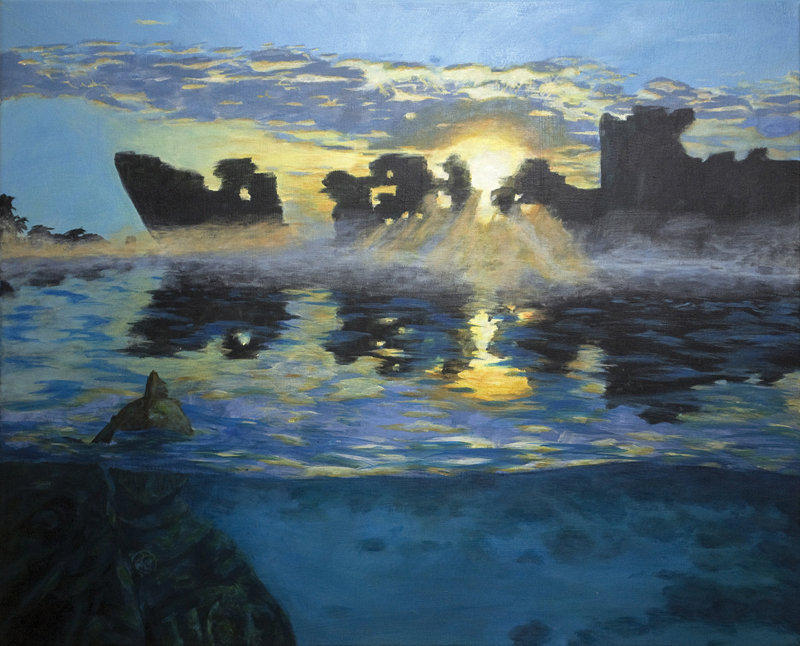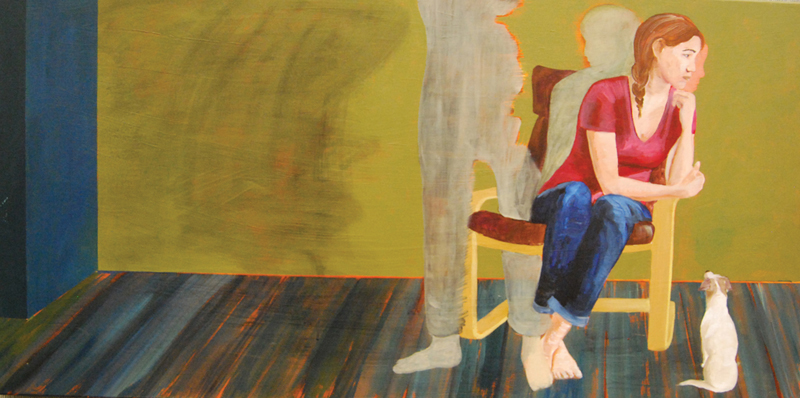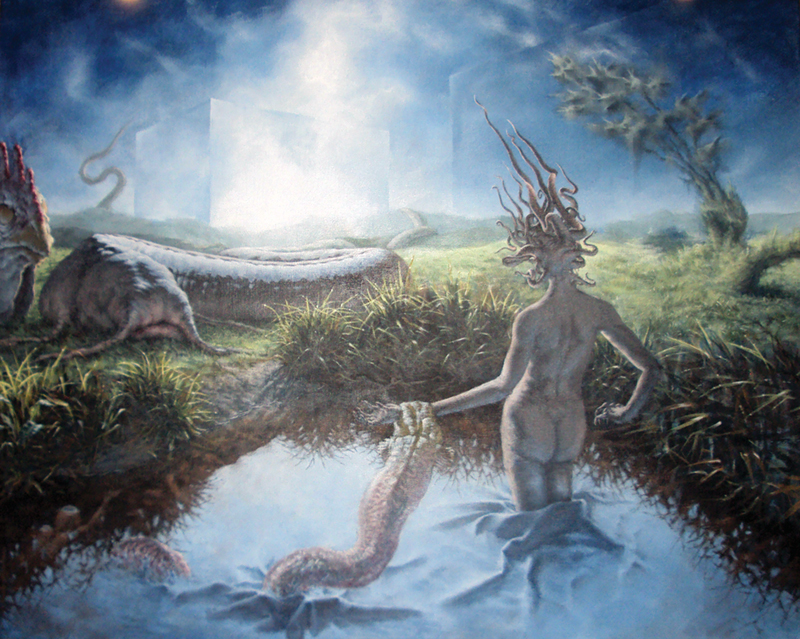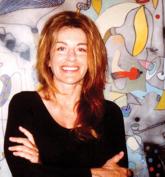Humanities, Sciences, Must Be United For Our Collective Success
Spring
2013
Feature
Connecting Worlds
Humanities, Sciences, Must Be United For Our Collective Success
Carla Poindexter, University of Central Florida
![Art student Paul Finch, whose contributions to the STEAM Project at UCF have produced several controversial STEM inspired artifacts, points out that historically, many scientists were artists, and the two fields often overlapped. Michelangelo, for example, was a sculptor, painter and poet in addition to being an architect and engineer, American inventors Robert Fulton and Samuel F.B. Morse were portrait painters before they invented the steamship and the telegraph, respectively. “Most of us [artists] know more about science than people expect,” Finch said. Photo by Ivan Riascos. Art student Paul Finch, whose contributions to the STEAM Project at UCF have produced several controversial STEM inspired artifacts, points out that historically, many scientists were artists, and the two fields often overlapped. Michelangelo, for example, was a sculptor, painter and poet in addition to being an architect and engineer, American inventors Robert Fulton and Samuel F.B. Morse were portrait painters before they invented the steamship and the telegraph, respectively. “Most of us [artists] know more about science than people expect,” Finch said. Photo by Ivan Riascos.](/sites/default/files/images/publications/Radiations/2013/Spring/connworlds-humanities-finch-paul.jpg)
When Pablo Picasso presented his first cubist paintings to the world, even most educated people thought them hideous and irrational, yet his peers saw them to be ingenious. Likewise, Albert Einstein’s theory of relativity was equally baffling to the uninitiated.
But to those who were knowledgeable about both art and physics, parallels would have been recognized between Einstein’s new visions of reality and Picasso’s paintings that could be viewed from multiple points of view in simultaneous space and time. They might also have speculated that Einstein’s visionary physics may have directly inspired Picasso’s revolutionary paintings—or was it the other way around? How is it that the sciences and the arts have lost their interconnectivity in our contemporary educational cultures?
At the highest levels of innovative thought, art and physics share a common goal: the investigation of reality. Both begin with observation. Art tends to communicate through metaphor and poetics. Science communicates through logic and mathematics. Both disciplines seek to foster and produce creative and innovative problem solvers.

As an upper level fine arts educator, I have come to realize that the most immediate issue facing our future is not the ongoing budget deficiencies in state and national support, but the lack of awareness or interest in our discipline outside the College of Arts and Humanities. The insulated art world is probably equally responsible for this dilemma in our contemporary society. However, at the university level, a way to bridge the gap is through collaborative academic activities.
Two almost overlapping events in Orlando, FL—a NSF sponsored student art exhibition and a national physics conference—serve as examples where both disciplines were enhanced by the other.
One event was the STEAM Exhibition: “Searching for Ultimate Truth in Science and Art,” an exhibition of STEM inspired artifacts by University of Central Florida’s (UCF) fine art students. The curriculum acronym STEM stands for Science, Technology, Engineering and Mathematics, but the arts more and more are becoming wedged into the mix to create STEAM (Science, Technology, Engineering, Arts and Mathematics).

The foci of the exhibition were artworks created by fine art painting and sculpture students who challenged STEM and non-STEM viewers to interpret the science inspired artworks through visual metaphor. The work presented offered commentaries on the potentials for both good and harm to humanity and the earth.
The overlapping conference was the 2012 Sigma Pi Sigma Quadrennial Physics Congress, also known as PhysCon. This year’s theme was “Connecting Worlds through Science and Service.” As the PhysCon brochure announced: “From global warming to Facebook to the International Space Station, we’re realizing now, more than ever, how connected we all are – as physicists, as scientists, as members of society, as humans, and as part of a vast universe.”
At the Congress, it was often acknowledged that as scientific research and knowledge become increasingly more specialized and complex, outreach and education becomes more important.
Two popular sessions at the Congress highlighted professionals who cross both disciplines to communicate complex ideas through art and emerging media. The first was Henry Reich, the creator and animator of the popular YouTube video series called “MinutePhysics.” In his series, Reich illustrates, “cool topics in physics” through a series of expressive drawings and conversational dialog. The other session featured David Saltzberg, the science consultant to the popular sitcom, “The Big Bang Theory.” His contribution to the show is to work with artists – the scriptwriters, art directors, prop designers and actors – to make sure the science behind the show is correct.
The 2012 Congress also included its second fine art contest of paintings, drawings, photography, and digital mixed media artworks. Jordan Guzman, Bachelor of Fine Arts painting major at UCF, was awarded first-place in the category of “Connecting Worlds.” At UCF, she responded enthusiastically to the opportunity to work with STEM inspired subject matter, especially physics.
Describing her painting, “Nothing Going On Here, Or So It Seems” (pictured in the "PhysCon Art Contest" article), inspired by a presentation on the Multiverse by Mathematics and Physics Professor Costas Efthimiou, Guzman states,
“I am responding symbolically to the way we interact with the environment, the space and time that surrounds us. Space is often thought of as being far away from us, some think only of outer space. However, current research informs us that is not so. Although we do not fully understand what space is, we are more familiar with it than we realize. In a lonely room, the apparent nothingness imposes itself onto every crevice. Matter and space constantly interact with each other. From moments of stillness to moments of fierce energetic movement, there is more push and pull than we can ever fathom.”

At the University of Central Florida, four major STEAM Exhibitions of science-themed artworks have been held since Spring 2011 in the University’s galleries. The most recent exhibition in April 2013 drew 500 visitors on opening night. For many of the hundreds of visitors who attend the opening night receptions, the artworks provide a visual doorway to the science behind the images, sparking enthusiasm and conversation throughout the crowds in the gallery spaces. The shows have consistently illustrated how images that emerge from collaborations between science and art students can provide provocative points of view to contemplate and discuss outside the traditional science classroom. In January 2013, UCF student produced STEAM artifacts were exhibited for the first time outside of an academic art gallery setting during the popular Otronicon event at the Orlando Science Center where 7,000 visitors attended a four day showcase of new interactive media and virtual systems.
As Florida and other states wrestle with current pressing issues of how best to fund and facilitate effective educational preparedness for future students, perhaps legislators could take a larger view of the long-term issues facing our young people.
A solid education offers opportunities for students to become innovative problem solvers by encouraging them to seek out unanticipated interdisciplinary connectedness and by exposing students to more – not less – diversity.
This article originally appeared in the November 14, 2012 UCF Forum, and was adapted for use in Radiations.
 Carla Poindexter is an associate professor of fine art at the University of Central Florida, a Co-PI of UCF’s ICubed Initiative, and a columnist for the UCF Forum, an opinion series by a panel of faculty, staff and students. She can be reached at Carla.Poindexter [at] ucf.edu.
Carla Poindexter is an associate professor of fine art at the University of Central Florida, a Co-PI of UCF’s ICubed Initiative, and a columnist for the UCF Forum, an opinion series by a panel of faculty, staff and students. She can be reached at Carla.Poindexter [at] ucf.edu.
The University of Central Florida welcomes opportunities to share information about its STEAM Initiative and encourages opportunities for collaborative exhibitions and forums with other academic institutions. For more STEAM information and artwork, see: http://icubed.ucf.edu/steam.php.
